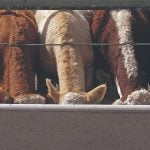Compared to last week, western Canadian yearling prices markets traded $2-$5 higher on average. Calves were quite variable. This was the first week when larger groups of calves were featured on the internet sales. Prices on the internet appeared to be significantly stronger than smaller groups under 10 head moving through auction rings. Feedlot operators were willing to pay up to buy 100 to 200 head of calves in one purchase at one location. The weaker Canadian dollar set a firmer tone while the deferred live cattle futures continued to trade near contract highs. Some feedlot operators are reporting profitable margins on current pen closeouts which has also contributed to stronger replacement values.
Read Also

U.S. livestock: Feeder cattle hit contract highs on tight supply
Chicago | Reuters – All Chicago Mercantile Exchange feeder cattle futures and most live cattle futures hit contract highs on…
The quality of yearling cattle coming on the market is excellent. Lower flesh levels with superior genetics have enhanced the market structure. Grass conditions have been favourable in Alberta. In certain regions of northern Alberta and northern and east-central Saskatchewan, yearlings have come off luscious grass conditions. The astute buyer may be factoring in a better efficiency on cattle from drier parts of the Alberta foothills. Like everything else, grazing cattle has become more of a science and the markets are reflecting the competitive edge.
South of Edmonton, a small group of mixed steers with full health data off grass weighing 945 lbs. were quoted at $229. In west-central Alberta, larger-frame Simmental-based steers with full health records fresh off grass weighing 855 lbs. were valued at $245. West of Calgary, Charolais-based grass steers averaging 940 lbs. were reported at $235. In the Lethbridge area, tan steers fresh off grass weighing 850 lbs. were valued at $252 landed in the feedlot. Southeast of Calgary, Hereford-blended heifers off grass averaging 825 lbs. were quoted at $228 landed in the feedlot. Similar to last week, freight spreads between Saskatchewan and southern Alberta were noted in the yearling market.
In central Saskatchewan, larger-frame black mixed steers averaging 710 lbs. reached up to $262. In the same region, Charolais-based heifers averaging 730 lbs. reportedly moved at $242.
The benchmark for calves was an average steer weight of 500 lbs. trading just under the psychological $300 level. A larger group of mixed steers weighing 530 lbs. in east-central Alberta were quoted at $295. In southern Alberta, a larger group of mixed heifers averaging 500 lbs. were reported at $260. In central Alberta, larger-frame black weaned steers weighing 640 lbs. were valued at $270 and mixed weaned heifer calves averaging 670 lbs. were quoted at $247.
As of July 1, the number of feeder cattle outside finishing feedlots (cow-calf and backgrounding operations) in Western Canada were down approximately 250,000 head from year-ago levels, according to Statistics Canada. The number of feeder cattle outside finishing feedlots in the U.S. as of July 1 was down one million head from July 1, 2021 according to USDA. It takes time for the market to digest the tighter fundamental structure.
— Jerry Klassen is president and founder of Resilient Capital, specializing in proprietary commodity futures trading and market analysis. Jerry consults with feedlots on risk management and writes a weekly cattle market commentary. He can be reached at 204-504-8339 or via his website at ResilCapital.com.















